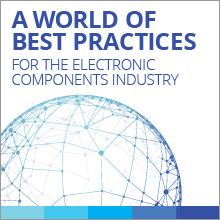AS6496 Authorized Distributor Anti-Counterfeiting Standard
SAE Aerospace on August 20, 2014 announced the adoption of AS6496, a standard for “Fraudulent/Counterfeit Electronic Parts: Avoidance, Detection, Mitigation and Disposition – Authorized/Franchised Distribution. The standard sets forth the requirements for mitigating counterfeit products in the authorized distribution supply chain by distributors performing authorized distribution.
The standard will be used by aerospace companies to reduce the risk of counterfeit electronic parts entering the aerospace supply chain. It is possible that the standard may be used as an anti-counterfeiting model by customers in other industries.
Authorized distribution is defined as “transactions conducted by a manufacturer-authorized distributor distributing product within the terms of a distribution agreement.” If sales are done without a distribution agreement in place, then the distributor is not performing authorized distribution and a different SAE standard applies, AS6081, which applies to independent distributors/brokers.
There are two other definitions that are of interest to ECIA members – authorized reseller and master distributor. For purposes of AS6496, an authorized reseller is not considered an authorized distributor. A master distributor may or may not be an authorized distributor. Consequently, when a distributor purchases from a master distributor, the distributor must verify from the manufacturer that products purchased through a master distributor are considered authorized distribution.
AS 6496 requires authorized distributors to:
- Have a counterfeit mitigation policy;
- Have a counterfeit electronic parts control plan; and
- Sets forth certain customer-related processes.
The standard is divided into six major sections addressing:
- Customer-related processes
- Purchasing
- Traceability, Record Retention and Retrievability
- Returns – Control of Suspect, Fraudulent and Confirmed Counterfeit Parts
- Scrap Control of Suspect, Fraudulent and Confirmed Counterfeit Parts
- Inventory Control Plan
Customer-Related Processes
There are two required processes related to customers:
- Disclosure in writing at the time of quotation if the distributor is not authorized for the item(s) being quoted.
- Providing the full manufacturer’s warranty support to the customer in accordance with the manufacturer’s warranty terms.
Purchasing
There are a number of provisions within this section regarding an authorized distributor’s purchasing practices. One provision requires the distributor to maintain a register of its suppliers, i.e., a list of the manufacturers or authorized distributors that provide product to the distributor for sale to the customer. The list must also show authorization status and scope.
Another provision makes it clear that it is only authorized distribution if an authorized distributor buys solely from the manufacturer or the same manufacturer’s authorized distributor. This means that if a distributor is authorized by X manufacturer, it can only get product from X manufacturer or another X manufacturer’s authorized distributor. Obtaining the product from any other source is not considered authorized distribution.
Traceability
The traceability section sets forth the documentation requirements for military parts and commercial/industrial parts. Military parts require both the manufacturer’s and the distributor’s certificate of conformance, while only the distributor’s certificate of conformance is required for commercial parts. There is also a provision that spells out the contents of the authorized distributor’s certificate of conformance.
Returns
The returns section contains provisions regarding elements of a returns policy, return verification, disposition of suspect and confirmed counterfeit parts, and re-stocking.
The standard requires the distributor to issue an RMA if it elects to accept a return. The RMA must require that the parts returned by the customer were the same parts sold to the customer. If the distributor agrees to accept parts that it did not sell, then those parts must not be co-mingled in inventory nor sold to anyone else as authorized product. In addition, parts returned by independent distributors/brokers must be treated as suspect counterfeit parts.
The customer return verification provisions specify the elements necessary to prove that the parts returned by the customer to the distributor were purchased directly from the distributor and not some other source. These elements include:
- Matching the returned parts against the distributor’s traceability records, which should include date/lot codes if available. If date/lot codes are not available or don’t match, then the returned parts should be treated as suspect counterfeit parts.
- Customer returned parts are to be inspected for any evidence of alteration, mishandling, improper packaging or repackaging.
- If a distributor elects not to verify, then customer returned parts shall not be restocked or returned to the supply chain.
Suspect, fraudulent or counterfeit parts shall be quarantined pending proper disposition. The parts may be returned to the manufacturer for analysis and disposition. Confirmed counterfeit parts should not be returned to the customer and should be held in quarantine for five years, or longer if required by law.
The re-stocking provisions reiterate that suspect, fraudulent and counterfeit parts must not be reintroduced into the supply chain, restocked or returned to the manufacturer in a stock rotation. In addition, returned parts shall not be restocked into authorized inventory if purchased from non-authorized sources.
Scrapping
The scrap provisions require scrap records and records of outsourced destruction. These records are to be kept for five years.
Inventory Control Plan
Distributors are required to have system for controlling inventory that includes the segregation of authorized parts from unauthorized parts and the traceability of customer returned parts.
The AS6496 standard was developed by an SAE Committee, G-19AD, comprised of representatives from authorized distributors, aerospace companies and government agencies. The G-19AD Committee was co-chaired by ECIA’s Robin Gray and TTI’s Kevin Sink. The final document is available for purchase from SAE.


